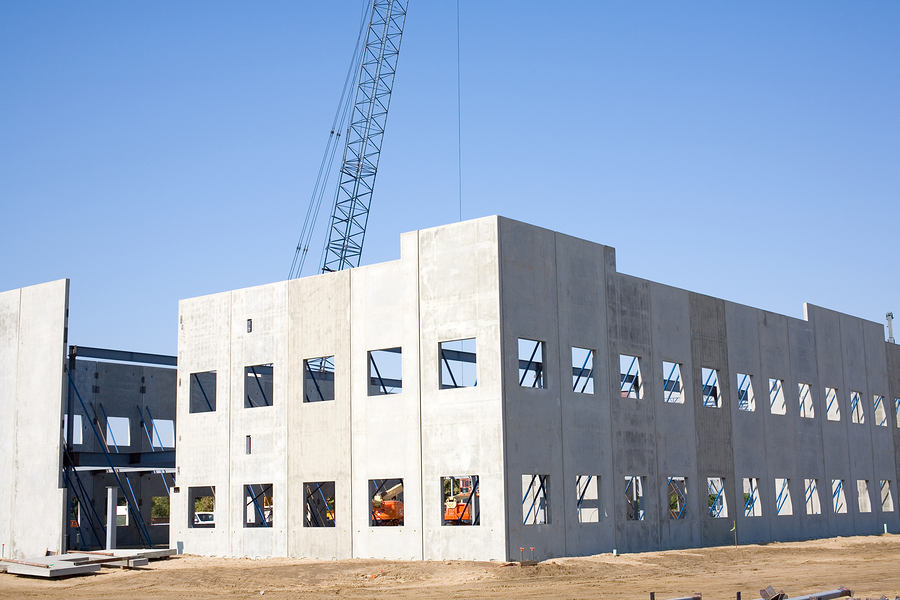If we compare traditional casting construction to precast concrete, perhaps the biggest difference is time, which precast construction might save significantly. While cast-in-situ concrete is poured into specific erected formwork on the site and cured to gain desired properties, precast concrete elements are transported to the site, where they’re lifted and positioned in the predetermined space.
In the early stages in development, precast construction relies heavily on the design team, and this joint effort early on saves the money and time needed for `the building completion in the long run. Let’s explore the reasons why this type of building is winning over traditional concrete casting.
Increased control
Although the concept of control can often feel elusive in the construction industry, by using precast concrete, managers are allowed more control over the job site and schedule. The individual pieces are poured and cured in controlled industrial environment and then stored until they’re needed on the site. In other words, you’re getting a high-quality product that requires less on-site labour and has less impact on the site. In addition, since concrete elements are produced in climate-controlled conditions, tight manufacturing tolerances can be delivered, which in return guarantees longevity and structural strength of the building.
Larger savings
Since production of precast concrete is more easily controlled, the quality and durability of the elements is much better than in cast-in-situ concrete. Due to the volume of the purchase, a precast manufacturer is also more likely to receive discounts on materials, which can be used for multiple projects at a time. And as the amount of labour required to precast concrete is also less than for curing concrete on site, there are savings to be made on both accounts.
Ease of installation
The simplicity and speed of precast concrete design contributed to the popularity of the concept, which is now widely used for both commercial and residential buildings, wherever high-quality and environmentally-sustainable solutions are needed. Precast manufacture isn’t weather-dependant, like traditional on-site casting, and shorter schedules and delivery times allow for a cleaner and safer construction site.
Tilt-up construction
As a subdivision of precast construction, tilt-up system seems to combine the best of both worlds. The main difference between tilt-up and standard precast construction is the location where concrete panels are formed. Tilt-up panels are poured on the job site using a casting bed, and then lifted into place using cranes. Although in this case, weather conditions need to be taken into consideration, this type of casting has many benefits to it.
Tilt-up vs. regular precast
First, casting on site eliminates the needs of transportation and the associated costs. Second, as they don’t require transportation, tilt-up panels can be extremely large or tall. Thirdly, precasting on-site offers almost limitless flexibility, unlike factory precasts, which are made using standardized one-size-fits-all moulds.
Tilt-up construction is first used in the U.S. around 1905, but gained widespread popularity in the post WW2 construction boom. Although tilt-up was rarely used in Australia until 1969, ask these experts for tilt panel construction from Brisbane today, and they’ll tell you why tilt-up is the right choice for your new business.
Noise reduction
Precast concrete is much denser and sturdier than one poured and cured in on-site formwork, which makes it a perfect material choice for buildings where soundproofing is a top priority. It’s the very reason why commercial buildings in large metropolitan areas choose precast concrete over other solutions. It goes without saying that multi-family residential buildings and student dormitories also benefit from precast as it limits noise transfer from floor to floor.
Aesthetics and user satisfaction
The days of boring, grey concrete monstrosities are long gone. With a vast choice of aggregates, shapes, colours and finishes, precast design offers the end-user a multitude of options. Other materials, such as brick, stone and granite can be infused into the cast at the factory, reducing the time, complexity and cost of on-site installation.
As a result, precast commercial building allows for a high-quality business environment which can be delivered in relatively short period, and tailored to the customer’s needs. Building on the many widely known benefits of concrete, precast concrete has its own unique set of advantages. On top of it being durable and versatile, the simplicity and ease of installation both shorten the time and reduce the impact on the environment.


It’s fantastic to learn that you can save a lot in the long run with precast concrete for your building. My wife and I are wanting to start a small company and we were wondering how we could save on the building costs of an office building if we get to that point. I’ll be sure to tell her that we should consider using precast concrete for the building if it gets built.
By using precast technology, construction progress is much faster. Hopefully the development of precast technology in the future is growing rapidly and rapidly
It’s interesting that precast concrete can be so beneficial for buildings. I can see how that would save a lot of money in the long run! It’s harder to cast concrete vertically like that, after all.
Thank you for the info precast, I always read this website to find out various info on the development of the construction world and its various innovations